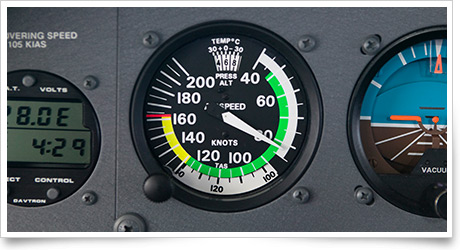| The following stories from the Dec. 7, 2012, edition of AOPA ePilot were provided to AOPA members who expressed an interest in the particular subject areas. Any AOPA member can receive information tailored to their areas of interest by updating their preferences online. |
training tipsColorful warnings
Fortunately, color-coded airspeed indicators installed in FAA-certificated aircraft manufactured after 1945, and of 12,500 pounds or less, can alert the pilot at a swift glance to airspeed in need of correction during the approach and landing sequence.
Downwind, preparing to decelerate and descend, the pilot reduces power to a predetermined setting and maintains altitude with gentle back pressure to slow the aircraft from the normal operating range (green arc) into the approach-speed realm (white arc). When the airspeed enters the white arc, the aircraft is ready for configuration changes.
The white arc is “commonly referred to as the flap operating range since its lower limit represents the full flap stall speed and its upper limit provides the maximum flap speed. Approaches and landings are usually flown at speeds within the white arc,” explains Chapter 7 of the Pilot’s Handbook of Aeronautical Knowledge. (Questions on this subject appear on the Private Pilot Knowledge Test; review Learning Statement Code PLT088.)
Retrimming hastily for the new configuration is frequently a cause of airspeed errors. Be sure the aircraft has stabilized under the new power-pitch-flaps combo—or the outcome will not be what you had in mind.
Stabilized? Power changes can now control the descent until you change the flap setting again, when retrimming will again be needed. If you plan to maintain the current airspeed when adding flaps, remember to lower the nose to offset the additional induced drag.
The airspeed indicator’s color coding—including the cautionary yellow arc, and the red radial line depicting V NE (never-exceed speed)—sends easy-to-interpret safety messages in other phases of flight such as cruise flight and during maneuvers.
Not all important airspeeds are depicted. Practice locating other values such as design maneuvering speed, and speeds for best rate and best angle of climb, finding them on placards or in your pilot’s operating handbook, for easy reference now, and to demonstrate knowledge to the designated examiner during your flight test. training productsPilot Mall features flight bags, pilot luggageFlight bags play an invaluable role for pilots and aviators. With pilot bags, aviators can have quick access to navigation charts, flight plans, fuel testers, headsets, airport directories, portable GPS receivers, and much more. Check out a complete list of offerings from Pilot Mall to help with your holiday shopping for the student pilot in your life.
Note: Products listed have not been evaluated by ePilot editors unless otherwise noted. AOPA assumes no responsibility for products or services listed or for claims or actions by manufacturers or vendors. final examQuestion: I just started flight training and my instructor has me pull out the mixture control knob to shut the engine off. Why not just turn the ignition switch to off?
Answer: Your instructor has you pulling out the mixture control knob to shut down the engine so there is no fuel left in the cylinders when the engine stops running. By pulling out the mixture control knob, you are shutting off the fuel supply to the engine and the fuel remaining in the cylinders is used up before the engine stops running. This minimizes the risk of an inadvertent startup in the event of a bad P-lead. The P-lead is a wire that grounds the magneto to the airframe. If this wire is broken or disconnected, the mag won’t be grounded when it should be, including when the ignition switch is off. If the propeller is bumped or turned by hand accidentally, the engine could start if there is fuel remaining in the cylinders. For more information, read “The Magneto Check.”
Got a question for our technical services staff? Email [email protected] or call the Pilot Information Center, 800/872-2672. Don’t forget the online archive of “Final Exam” questions and answers, searchable by keyword or topic. |
 The most reliable way to achieve a stabilized final approach, crowned by a
The most reliable way to achieve a stabilized final approach, crowned by a 

